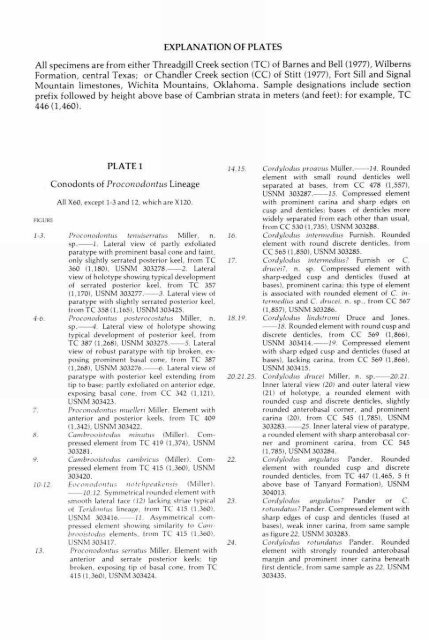View - KU ScholarWorks - University of Kansas
View - KU ScholarWorks - University of Kansas
View - KU ScholarWorks - University of Kansas
You also want an ePaper? Increase the reach of your titles
YUMPU automatically turns print PDFs into web optimized ePapers that Google loves.
EXPLANATION OF PLATES<br />
All specimens are from either Threadgill Creek section (TC) <strong>of</strong> Barnes and Bell (1977), Wilberns<br />
Formation, central Texas; or Chandler Creek section (CC) <strong>of</strong> Stitt (1977), Fort Sill and Signal<br />
Mountain limestones, Wichita Mountains, Oklahoma. Sample designations include section<br />
prefix followed by height above base <strong>of</strong> Cambrian strata in meters (and feet): for example, TC<br />
446 (1,460).<br />
FIGURE<br />
PLATE 1<br />
Conodonts <strong>of</strong> Proconodon tus Lineage<br />
All X60, except 1-3 and 12, which are X120.<br />
1-3. Proconodontus tenufserratus Miller, n.<br />
sp. 1. Lateral view <strong>of</strong> partly exfoliated<br />
paratype with prominent basal cone and faint,<br />
only slightly serrated posterior keel, from TC<br />
360 (1,180), USNM 303278. 2. Lateral<br />
view <strong>of</strong> holotype showing typical development<br />
<strong>of</strong> serrated posterior keel, from TC 357<br />
(1,170), USNM 303277. 3. Lateral view <strong>of</strong><br />
paratype with slightly serrated posterior keel,<br />
from TC 358 (1,165), USNM 303425.<br />
4-6. Proconodontus posterocostatus Miller, n.<br />
sp.-4. Lateral view <strong>of</strong> holotype showing<br />
typical development <strong>of</strong> posterior keel, from<br />
TC 387 (1,268), USNM 303275. 5. Lateral<br />
view <strong>of</strong> robust paratype with tip broken, exposing<br />
prominent basal cone, from TC 387<br />
(1,268), USNM 303276. 6. Lateral view <strong>of</strong><br />
paratype with posterior keel extending from<br />
tip to base; partly exfoliated on anterior edge,<br />
exposing basal cone, from CC 342 (1,121),<br />
USNM 303423.<br />
7. Proconodontus muelleri Miller. Element with<br />
anterior and posterior keels, from TC 409<br />
(1,342), USNM 303422.<br />
8. Cambrooistodus minutus (Miller). Compressed<br />
element from TC 419 (1,374), USNM<br />
303281.<br />
9. Cambrooistodus cambricus (Miller). Compressed<br />
element from TC 415 (1,360), USNM<br />
303420.<br />
10-12. Eoconodontus notclipeakensis (Miller).<br />
10,12. Symmetrical rounded element with<br />
smooth lateral face (12) lacking striae typical<br />
<strong>of</strong> Teridontus lineage, from TC 415 (1,360),<br />
USNM 303416. 11. Asymmetrical compressed<br />
element showing similarity to Cambrooistodus<br />
elements, from TC 415 (1,360),<br />
USNM 303417.<br />
13. Proconodontus serratus Miller. Element with<br />
anterior and serrate posterior keels; tip<br />
broken, exposing tip <strong>of</strong> basal cone, from TC<br />
415 (1,360), USNM 303424.<br />
14,15. Cordylodus proavus Iler. 14. Rounded<br />
element with small round denticles well<br />
separated at bases, from CC 478 (1,557),<br />
USNM 303287. 15. Compressed element<br />
with prominent caria and sharp edges on<br />
cusp and denticles; bases <strong>of</strong> denticles more<br />
widely separated from each other than usual,<br />
from CC 530 (1,735), USNM 303288.<br />
16. Cordylodus intertnedius Furnish. Rounded<br />
element with round discrete denticles, from<br />
CC 565 (1,850), USNM 303285.<br />
17. Cordylodus intermedius? Furnish or C.<br />
drucei?, n. sp. Compressed element with<br />
sharp-edged cusp and denticles (fused at<br />
bases), prominent caria; this type <strong>of</strong> element<br />
is associated with rounded element <strong>of</strong> C. intermedius<br />
and C. drucei, n. sp., from CC 567<br />
(1,857), USNM 303286.<br />
18,19. Cordylodus lindstromi Druce and Jones.<br />
18. Rounded element with round cusp and<br />
discrete denticles, from CC 569 (1,866),<br />
USNM 303414. 19. Compressed element<br />
with sharp edged cusp and denticles (fused at<br />
bases), lacking caria, from CC 569 (1,866),<br />
USNM 303415.<br />
20,21,25 Cordylodus drucei Miller, n. sp. 20,21.<br />
Inner lateral view (20) and outer lateral view<br />
(21) <strong>of</strong> holotype, a rounded element with<br />
rounded cusp and discrete denticles, slightly<br />
rounded anterobasal corner, and prominent<br />
caria (20), from CC 545 (1,785), USNM<br />
303283. 25. Inner lateral view <strong>of</strong> paratype,<br />
a rounded element with sharp anterobasal corner<br />
and prominent caria, from CC 545<br />
(1,785), USNM 303284.<br />
22. Cordylodus angulatus Pander. Rounded<br />
element with rounded cusp and discrete<br />
rounded denticles, from TC 447 (1,465, 5 ft<br />
above base <strong>of</strong> Tanyard Formation), USNM<br />
304013.<br />
23. Cordylodus angulatus? Pander or C.<br />
rotundatus? Pander. Compressed element with<br />
sharp edges <strong>of</strong> cusp and denticles (fused at<br />
bases), weak inner caria, from same sample<br />
as figure 22, USNM 303283.<br />
24. Cordylodus rotundatus Pander. Rounded<br />
element with strongly rounded anterobasal<br />
margin and prominent inner caria beneath<br />
first denticle, from same sample as 22 . USNM<br />
303435.
















